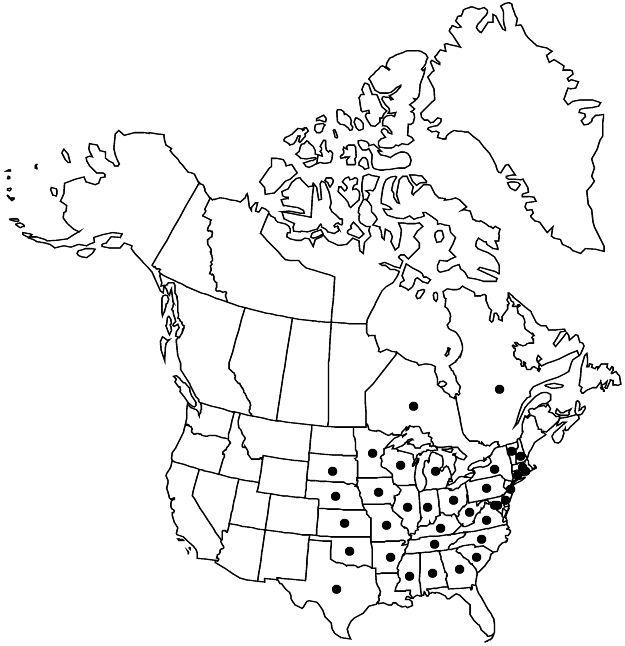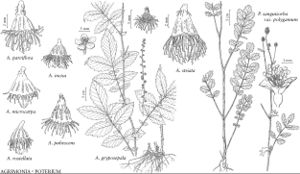Agrimonia pubescens
Beitr. Bot. 1: 45, plate 1, fig. 7. 1842.
Herbs, 5–16 dm. Roots: tubers ± fusiform. Stems with short-stipitate-glandular hairs and pubescent to villous and hirsute (hairs scattered, erect, 2–3 mm, stiff). Leaves: mid cauline stipules ± broadly 1/2-ovate, margins dentate, apical lobes sometimes attenuate; major leaflets 3–13 (mid cauline 5–9), minor 1 or 1–3 pairs; major leaflet blades elliptic or narrowly elliptic to lanceolate, sometimes ± obovate (lateral sometimes ± falcate), terminal largest, largest of these 3.3–9.8 × 1.4–5.5 cm, margins serrate to dentate, apex obtuse to acute or acuminate, abaxial surface rarely with glistening glandular-hairs, pubescent to pilose and sparsely hirsute (hairs stiff, 1–2 mm, usually densest along major veins). Inflorescences: axes with short-stipitate-glandular hairs to villous and hirsute (hairs stiff, ± scattered, usually erect proximally and 1–3 mm to ± ascending distally and 1 mm). Flowers usually ± alternate. Fruiting hypanthia turbinate to campanulate, 1.9–4.5 × 2–4.6 mm, deeply to shallowly sulcate, hooked bristles in 3–4 circumferential rows, proximal row spreading ± 90° (pressed upward on dried specimens), glandular-hairy, grooves strigose, ridges sparsely hirsute (sepal bases usually pubescent along rim).
Phenology: Flowering mid Jul–Sep.
Habitat: Edges, open spaces, thickets, deciduous or mixed deciduous woods
Elevation: 0–1300 m
Distribution

Ont., Que., Ala., Ark., Conn., Del., D.C., Ga., Ill., Ind., Iowa, Kans., Ky., Md., Mass., Mich., Minn., Miss., Mo., Nebr., N.H., N.J., N.Y., N.C., Ohio, Okla., Pa., R.I., S.C., S.Dak., Tenn., Tex., Vt., Va., W.Va., Wis.
Discussion
Agrimonia pubescens includes three recognizable morphs. The principal patterns are: leaves with major leaflets more or less obovate to more or less elliptic, 5–7 leaflets on mid cauline leaves, 1 minor pair; leaves with major leaflets more or less narrowly obovate to elliptic, 7 leaflets on mid cauline leaves, 0–1 or 1–3 minor pairs; and, leaves with major leaflets elliptic to narrowly elliptic or lanceolate, 7–9 leaflets on mid cauline leaves, 0–1 or 1–3 minor pairs. Lateral major leaflets are frequently more or less falcate in morphs two and three. Stipules with attenuate apical lobes are usual in morph three and frequent in morph two. No discontinuities in the variation occur within A. pubescens, and all patterns of variation are found throughout the range. Plants resembling A. microcarpa in major leaflet shape and in the number of major and minor leaflets can usually be identified as A. pubescens by stipule shape, the presence or absence of stiff hairs on mature hypanthia ridges, and/or the lengths of stem hairs. Additional study is needed to establish the phylogeny and perhaps a more precise taxonomy of this species as well as its relationship to A. microcarpa. Eupatorium molle (Torrey & A. Gray) Nieuwland, which pertains here, is illegitimate.
Selected References
None.
Lower Taxa
"thin" is not a number.
